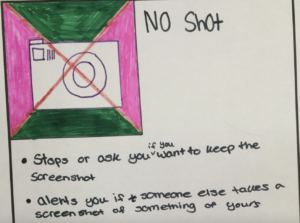When I ask kids why it is so easy to get into a fight over text messages, they know! “You don’t see the other person’s face!” they tell me. “Or hear their tone.” While some kids feel like emojis can bridge the gap, most acknowledge that it can be tough to communicated feelings via text, that humor is tricky, and that it is easy for things to go wrong. Group texts are their own special level of trouble.
Kids deal with small conflicts every day — it’s part of growing up. And of being forced into a community where they have little control of who they spend their days with in school. But social media and texting adds a new frontier. While smartphones allow us to be connected in ways we couldn’t even imagine when we were kids, technology has added layers of complexity to the social sphere.
If you are a regular reader, you know me to be very tech-positive. I believe that the benefits outweigh the hazards – if and only if we develop the necessary skill sets to use the technology the right way.
That’s good news. If we treat it like a skill set, that means it can be learned – and more importantly, taught. The challenge is that there’s a pretty wide continuum of unkind and difficult behaviors, ranging from perceived slights to thoughtlessness, unkindness to intentional drama and gossip, and in extreme cases, bullying.
A further challenge is that the rules, conventions, and expectations are still evolving. While it seems like text messaging has been around “forever,” it’s still new enough that everyday behavior is not yet governed by a clear set of cultural norms. It’s still very much in flux, which makes parents feel like they are “behind the times,” and “can’t keep up” with what their kids know.
More good news—if you feel equipped to help your kids handle a face-to-face conflict, then you are just as equipped to help them handle online issues as well. Like I said, it’s a skill set.
The Screen Connects, but the Screen Distorts
It is easy to forget there is another human being on the end of digital communication – to feel less empathetic when there’s a screen in between us. Also, difficult emotions can be tempered, twisted, or misconstrued when filtered through the screen. Sometimes we say things online that we would not say in person.
Choosing a communication medium wisely—and not out of fear—is part of the skill set of conflict resolution. We as parents and mentors need to talk explicitly with kids about how to decide when digital communications are appropriate, and when to talk in person.
You may see this in your own workplace, where an e-mail miscommunication leads to a chain of conflict. What do you do? Walk down the hall or pick up the phone! The appropriate medium makes a huge difference, and you can teach the same skills to your kids.
Unintentional Harm: Gossip
Gossip has been around since humans could communicate. However, technology can be an accelerant, enabling it to spread more quickly via social media, text messaging, or group chat.
Also, what happens when we are “recruited” into other people’s conflicts? What if a nasty exchange erupts as part of a group text, or someone posts a rude comment on someone else’s Facebook post? Do you get involved? Will that help—or make it worse? As I say frequently, conflict can be a spectator sport.
We definitely DON’T want to encourage kids to screenshot and share what is said in a text. Unless there is a threat that needs to be reported. But if someone is simply talking smack about someone else…DO NOT screenshot or forward. One group of kids I spoke with even invented this app called “No shot” to prevent this!

Intentional Harm: Bullying
Like gossip, bullying has been around forever, too. What’s different now then? Social media, texting, and hand-held devices provide kids with more tools to cause harm to one another.
It is incredibly easy to intentionally stir up drama between others by sharing something that you know might be upsetting. Or posting in ways that are intentionally vague and “coded” so that they will not be understood by everyone—but definitely understood by the person being attacked.
It’s important for parents and teachers to detect the nuanced differences between minor, everyday conflicts (which are very normal) and things that have escalated to intentional harm. Knowing where that line is allows you to be proactive in helping the child manage the situation. Resolving “true” bullying almost always requires the help of an adult.
Cyberbullying.org is a helpful organization for resources and support around online bullying.
Avoiding Conflict: No Reaction is a Good Reaction
There is a big difference between reacting and responding. Conflict usually requires a response, but a reaction can make it worse before it gets better. Think about that e-mail exchange—the back-and-forthW chain of reactions is almost always negative!
When we can, we should practice mindfulness and NON-REACTIVITY. Take a breath. Research shows that we actually hold our breath when checking email. We want oxygen in our brain.
Kids complicate this further. They commonly show their text messages to their friends (maybe to “recruit” others to their side), so many people may be evaluating a piece of communication. This usually doesn’t go well. Between two young people in middle school, any question can sound accusatory, and any answer can sound curt. It is very easy to commit an offense.
Face to Face Is Still the Best Way to Resolve Conflict
When all else fails, attempt to meet in person. Maybe with parents or teachers present, or maybe just kid to kid. We have to let kids know that when they get a message via Instagram, Snapchat, or Messenger that upsets them—stop and take a breath. Count to 10. Whatever creates space. Then, if possible, let’s try to talk face-to-face or at least by phone. Try not to let minor issues become major problems.
Kids communication centers around their devices. So it’s natural for technology to be their “go-to” in conflict resolution. After all, it’s how they communicate. But it is especially important for kids to understand that it is extremely difficult to repair an emotionally-charged situation without communicating in person.
Think of times where you were able to diffuse a disagreement in one face-to-face conversation—or even just a sympathetic look and the question, “do you want to talk?” You know how to do this, and you know how to teach your kids this. Devices don’t change the fact that it’s still just human communication.
Helping Kids with Conflict Resolution
Learning to get along in digital spaces is important, just like getting along at home or on the playground is crucial. This is why I repeat the mantra over and over again: Mentoring Over Monitoring.
Screenwise: Helping Kids Thrive (and Survive) in Their Digital World helps parents to be better mentors. And Growing Up in Public takes on social media, reputation, boundaries, and privacy.
Trying to control the technology is a fool’s errand – it changes too quickly, and your kids will often be ahead of the curve. However, thoughtful mentorship is the best way to help them learn how to manage their relationships – online and offline
.

